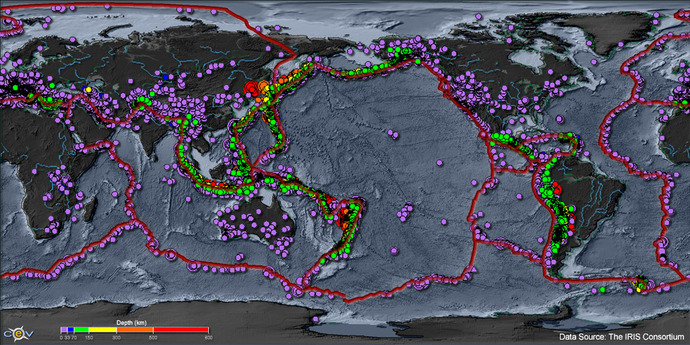Seismicity Shapes our Planet and Life
Seismicity plays a critical role in shaping the face of our planet, in creation of natural disasters, and in the past it has dramaically impacted Earths' climate by perturbation to gas hydrate deposits. The 2004 Sumatra tsunami generated by the Sumatra-Andaman earthquake (9.1-9.3 magnitude; ~ 300,000 people killed) and most recently the Scichua earthquake (7.8 magnitude;, 4.8 million homeless) in China serve as vivid reminders that our planet is dynamic and that earthquakes generate profound natural disasters resulting in significant human, economic, and property loss.
The Pacific Northwest, where significant Ocean Observatory resources will be focused (e.g. the cabled Regional Scale Nodes and cabled Coastal Scale Nodes) has experienced earthquakes similar to those in Sumatra and China as little as 300 years ago, and this region is believed to be over due for a megathrust event. It is also an area with a culturally/educationally-rich history of legends and traditions rooted in the regions earthquake and tsunami events (see Thunderbird and Whale). Development of the submarine RSN plate-scale seismic array coupled with seismic sensors deployed over the continental U.S. as part of NSF’s EarthScope program, make it an optimal place where researchers and educators can study seismic processes in real-time from the birth of the oceanic crust at spreading centers, to its destruction within subduction zones.
Although earthquakes as destructive processes (landslides, volcanic eruptions, tsunamis) are general knowledge, most of the public would be surprised to learn that, indeed, seismic processes are also important to generation of life itself. For example, in the deep sea, seismic events associated with underwater volcanoes at mid-ocean ridge spreading centers and within coastal accretionary margins result in the release of gases that serve as important energy and cell-building sources for microbes that thrive in the absence of sunlight. Some of these microbes are genetically the most ancient of organisms known on the planet and are capable of surviving at temperatures >120°C. Less than 1 % of these organisms have been cultured, and little is known about their metabolic activity-highlighting the fact that the ocean is still largely unexplored, and that profound discoveries will be made at the interface of geological, chemical, and biological studies.


